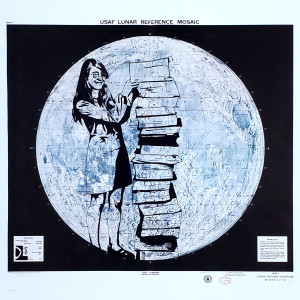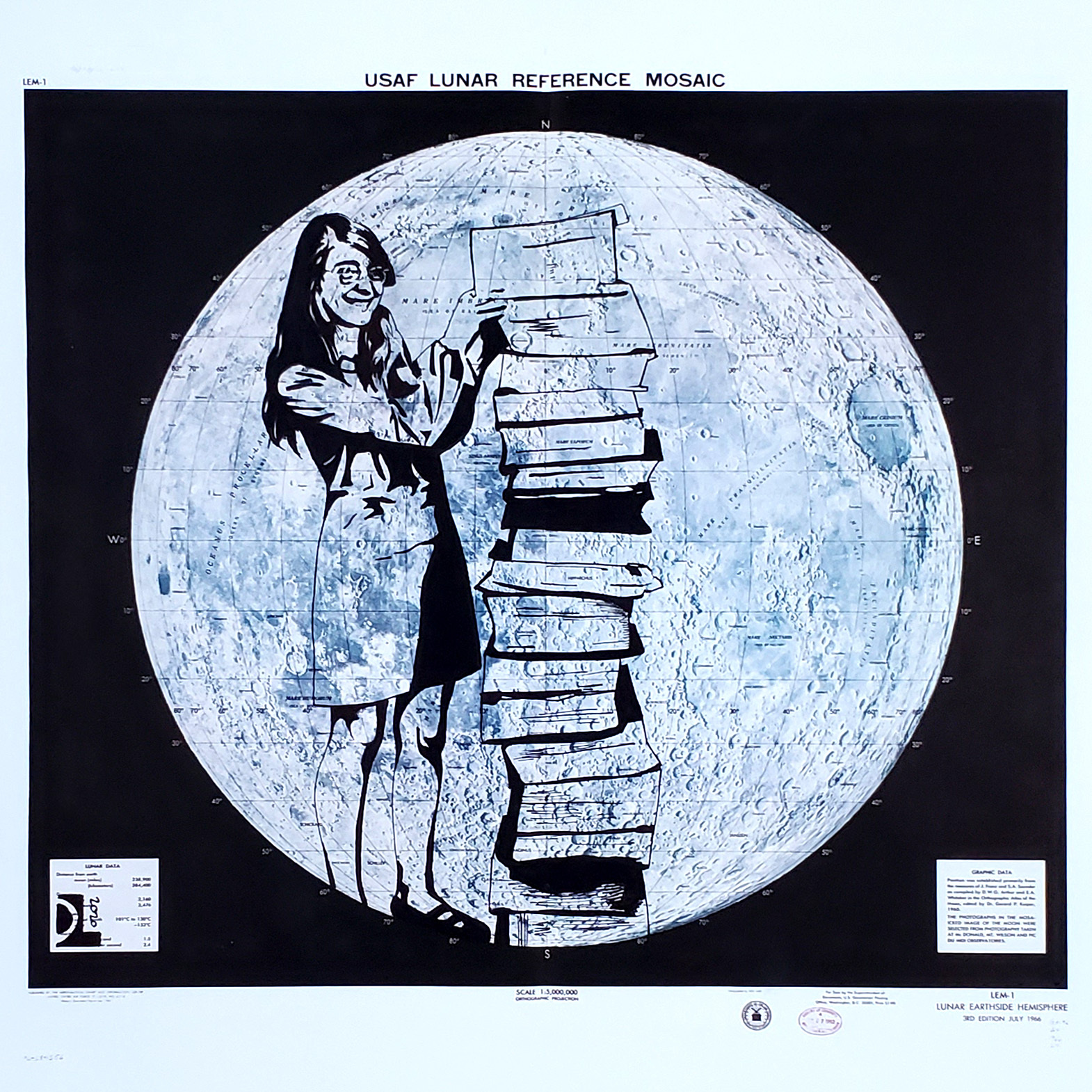
Tuesday Feb 22, 2022
Margaret Hamilton: Sending astronauts to the moon and back
“There was no choice but to be a pioneer.”
Margaret Hamilton
Mother of software engineering

Artwork:
Hamilton’s portrait in the Fearless Portrait project is based on an iconic photograph of her standing next to a stack of binders about as tall as she is. These binders contained the computer code she and her team wrote for the Apollo Mission. I’ve drawn her with black ink on a 1966 US Air Force map of the moon.
The Story:
On July 20, 1969, astronauts Neil Armstrong and Buzz Aldrin were three minutes away from making their historic landing on the moon when the lunar lander’s onboard computer began spitting out emergency alarms.
Faced with the critical choice of aborting the mission or not, flight controllers in Houston chose to trust the computer’s software that Margaret Hamilton, director of Apollo flight computer programming and her team at MIT’s Draper Laboratory developed.
“It quickly became clear the software was not only informing everyone that there was a hardware-related problem but was compensating for it,” said Hamilton.
It turned out that the astronaut’s checklist was at fault, telling them to set the rendezvous radar switch in the wrong position. The radar began bombarding the onboard computer with irrelevant information and overloading the computer. In a situation like this, Hamilton’s code dictated the computer should reboot. The restarting process allowed the computer to reprioritize tasks—ignoring the incoming radar information and focusing on the critical landing calculations.
“If the computer hadn't recognized this problem and taken recovery action, I doubt if Apollo 11 would have been the successful Moon landing it was,” Hamilton would later write.
In an era before screens, Hamilton and her team manually typed 11,000 pages of code writing the Apollo Project software. Stacked up, the software was the same height as Hamilton. The monumental achievement of putting a man on the moon was all the more impressive as the astronauts had access to a mere 72 kilobytes of memory. A standard smartphone today has more than million times more storage space.
Six and half hours after the fraught landing, Armstrong made his historic first step on the moon, saying, “That’s one small step for man, one giant leap for mankind.”
Background on Hamilton:
Hamilton was born on August 17, 1936 in Paoli, Indiana. After graduating in 1958 with a bachelor’s degree in mathematics, she took a job at MIT. It was supposed to be a temporary step, supporting her husband while he was in law school. It was here that she first learned what a computer was and how to write software. Her early experiences at MIT paved the way for her passion for building ultra-reliable software.
Initially planning to leave her job and pursue a master’s in abstract mathematics, she caught the programming bug and continued working at MIT when the university was asked to work on the Apollo space program.
“I was the first programmer to join and the first woman they hired,” she said. “Male engineers were already working on the project, but they were hardware engineers and it wasn’t their thing.”
Within a few years, she was leading a whole team of programmers at MIT in what would later be known as Draper Laboratory.
Her work as a computer scientist and a mother often collided and Hamilton would bring her daughter, Lauren, to the lab at night and on weekends. One day, Hamilton was running a simulation of a moon mission and Lauren began punching buttons like her mom.
Lauren began running a pre-launch program while the system was already “on the way” to the moon and the system crashed and erased the navigational data taking her to the moon.
“This could inadvertently happen in a real mission,” thought Hamilton and she pushed for software changes to address the issue. The higher-ups at NASA said the astronauts were too well trained to make such a mistake. On the very next mission—Apollo 8—astronaut Jim Lovell made the exact same error. NASA let Hamilton make the software fix after that.
Still in their infancy when Hamilton began her career, computer science and software engineering were not yet disciplines. Programmers often came from math backgrounds and learned on the job. As Hamilton put it, “there was no choice but to be pioneers.”
Ever the innovator, Hamilton coined the term “software engineering” while working on the Apollo project.
“I fought to bring the software legitimacy so that it—and those building it—would be given due respect. I began to use the term ‘software engineering’ to distinguish it from hardware and other kinds of engineering, yet treat each type of engineering as part of the overall systems engineering process. Software eventually and necessarily gained the same respect as any other discipline,” she explained.
Building on her Apollo work, Hamilton founded two companies—Higher Order Software (HOS) in 1976 and Hamilton Technologies in 1986.
Barack Obama awarded her the Presidential Medal of Freedom in 2016, saying, “Her example speaks of the American spirit of discovery that exists in every little girl and little boy who know that somehow, to look beyond the heavens is to look deep within ourselves—and to figure out just what is possible.”
Music:
This episode contains music by Geovane Bruno, Toma Mutiu, and Alex Chernykh.
Sources:
- American Experience. (2019, June 3). The Women Who Brought Us the Moon. American Experience | PBS. https://www.pbs.org/wgbh/americanexperience/features/chasing-moon-women-who-brought-us-moon/
- Cameron, L. (2020, August 11). First Software Engineer. IEEE Computer Society. https://www.computer.org/publications/tech-news/events/what-to-know-about-the-scientist-who-invented-the-term-software-engineering/
- Corbyn, Z. (2019, July 16). Margaret Hamilton: ‘They worried that the men might rebel. They didn’t.’ The Guardian. https://www.theguardian.com/technology/2019/jul/13/margaret-hamilton-computer-scientist-interview-software-apollo-missions-1969-moon-landing-nasa-women
- George, A. (2019, March 14). Margaret Hamilton Led the NASA Software Team That Landed Astronauts on the Moon. Smithsonian Magazine. https://www.smithsonianmag.com/smithsonian-institution/margaret-hamilton-led-nasa-software-team-landed-astronauts-moon-180971575/
- Hamilton, M. H. (n.d.). Margaret H. Hamilton Quotes. Citatis.Com. https://citatis.com/a7438/
- Matthews, D. (2019, July 17). Margaret Hamilton: the Apollo software engineer who saved the moon landing. Vox. https://www.vox.com/2015/5/30/8689481/margaret-hamilton-apollo-software
- McMillan, R. (2015, October 13). Her Code Got Humans on the Moon—And Invented Software Itself. Wired. https://www.wired.com/2015/10/margaret-hamilton-nasa-apollo/
- NASA. (2003, September 3). Margaret Hamilton. https://www.hq.nasa.gov/alsj/a11/a11Hamilton.html
- Obama, B. (2016, November 23). Remarks by the President at Presentation of the Presidential Medal of Freedom. Whitehouse.Gov. https://obamawhitehouse.archives.gov/the-press-office/2016/11/22/remarks-president-presentation-presidential-medal-freedom
- Senkal, M. (2020, May 20). History of Computer Girls, Part 2: Margaret! Metal Toad. https://www.metaltoad.com/blog/history-computer-girls-part-2-margaret
- Wikipedia contributors. (2021, November 23). Margaret Hamilton (software engineer). Wikipedia. https://en.wikipedia.org/wiki/Margaret_Hamilton_(software_engineer)
No comments yet. Be the first to say something!